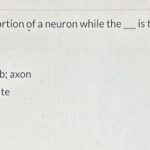The main receptive portion of the neuron is the dendrite, responsible for receiving signals from other neurons. Dendrites play a crucial role in transmitting electric or chemical signals between neurons.
Dendrites‘ branching structure and synaptic connections improve signal reception. They also play a critical role in facilitating information processing and neural communication within the brain. Gaining insight into dendrites’ importance in neuronal operation illuminates the intricacy of neural networks and the complex mechanisms that underlie cognitive processes.
By examining the dendrite as the principal receptive region, neuroscientists and researchers can elucidate the enigmatic mechanisms underlying the reception, processing, and transmission of information within neurons. It is crucial that we investigate dendritic function to increase our understanding of brain function and cognitive abilities.
The Central Unit Of Communication
The dendrite serves as the primary receptive portion of the neuron, receiving signals from the axon of the preceding neuron. This crucial component plays a key role in transmitting electric or chemical signals within the neuronal network.
| The dendrite is the main receptive portion of the neuron, receiving signals from the axon. |
| The axon passes signals to the dendrite through neurotransmitters in the synaptic cleft. |
| The dendrites and soma receive signals; E functions as a secretory region. |
| The cell body is not the major receptive region; it’s the dendrites where signals are received. |
| The dendrites, where neurotransmitters are located, are vital for signal transmission. |
| The soma houses the nucleus and organelles, providing energy for neuron functions. |
| Dendrites are crucial for receiving signals in neurons, making them the main receptive regions. |
Key Components Of A Neuron
The dendrite is the central receptive component of the neuron; it receives signals transmitted by the axon of the preceding neuron. It serves as the principal location for the reception of chemical and electric signals. Furthermore, the axon functions as the conduit for information, transmitting signals to the dendrite through the secretion of neurotransmitters within the synaptic cleft.
Dendrites As The Main Receptive Portion
Dendrites serve as the neuron’s central receptive region, where signals from the axon of the preceding neuron are received. Axon-to-dendrite signal transmission occurs via neurotransmitter release in the synaptic cleft. Signals are transmitted to the dendrites and soma of the cell by other neurons. The dendrite receives synaptic afferent inputs from neighboring neurons and serves as the central receptive region of the neuron. Additionally, it is the location of neurotransmitters that are critical for the transmission of neural signals. The soma, also called the cell body, is responsible for supplying energy to facilitate neuronal activity and for receiving neural signals transmitted from the dendrites to the axon, ultimately delivering them to another neuron or target effector cell.
Functionality Of Dendritic Spines
The neuron that comes before it sends information to the neuron that comes after it through its axon. It would help if you had to. It would help if you had it to send and receive chemical and electrical messages from other neurons. How the dendritic spines are arranged significantly affects how neurons work, which in turn affects how synapses connect. Most excitatory synaptic inputs in the brain and the spinal cord are found in dendritic spines. These spines help keep synaptic links strong and neurons talking to each other.
Comparing Dendrites And Axons
The dendrites are the parts in the middle of neurons that get information from the axon of the neurons before them. On the other hand, chemicals are sent from axons to dendrites through the synaptic hollow. There are many more branches at the ends of axons than there are on dendrites. Dendrites have long branches that are covered in synapses. An essential job of dendrites is to make it easier to join signals that come in and start electrical impulses. Axons, on the other hand, really send these messages to other brain cells or effector cells.

Credit: coggle.it
The Soma’s Contribution
The main receptive portion of the neuron is the dendrite, which receives signals from the axon of the previous neuron. It plays a crucial role in receiving electric or chemical signals and passing them along through neurotransmitters in the synaptic cleft.
| The Soma’s Contribution |
| Interplay Between Soma and Dendrites |
| The soma is the main receptive region of the neuron, crucial for receiving signals from other neurons. It plays a crucial role in neuronal health by providing energy to perform its tasks. The soma is located between the dendrite and axon, housing the neuron’s nucleus and specialized organelles. It collects neural signals from the dendrites and passes them on to the axon and other neurons or effector cells. The interplay between the soma and dendrites is essential for the transmission of neural signals and maintaining the overall health and function of the neuron. |
Neural Synapses: The Communication Hubs
The dendrite serves as the main receptive portion of the neuron, receiving signals from the axon of the previous neuron. It plays a vital role in transmitting electrical or chemical signals, functioning as a communication hub within neural synapses.
| Neural Synapses: The Communication Hubs |
| Synaptic Cleft and Transmission |
| Neurotransmitters: The Chemical Messengers |
Neurons are critical. When another neuron sends information, it goes to the dendrite, part of the neuron. The axon lets neurotransmitters out into the synaptic cleft. The dendrites are the part of the cell that can receive signals. The nerve cells next to them send them synaptic afferent messages. The cell body doesn’t just hold the neuron together; it also stores its genetic information and gives it energy to do its job. The dendrites also have neurotransmitters essential for sending messages between nerve cells.
Implications Of Dendritic Function
The dendrite serves as the primary receptive portion of the neuron, receiving signals transmitted from the axon of the preceding neuron. This essential function involves the reception of electric or chemical signals, aiding in the flow of neurotransmitters across the synaptic cleft.
| Implications of Dendritic Function |
| Receiving signals as electric or chemical signals, the dendrite is crucial in neurons. It receives signals from the previous neuron’s axon, which releases neurotransmitters. Dendrites and soma receive signals, while E is a secretory region for transmitting signals. |
| Impact on Learning and Memory |
| Neurons’ dendrites are key in learning and memory. They receive synaptic afferent inputs, containing neurotransmitters vital for signal transmission. Dendrites, not the cell body, are the main receptive regions. |
| Dendritic Dysfunctions and Disorders |
| Any dysfunction in dendrites can impact neural communication. Disorders affecting dendritic function may lead to disruptions in signal reception and transmission, affecting overall neuronal function. |
Advancements In Dendritic Research
A branch is the part in the middle of a cell that can get messages. Either chemicals or electricity are sent from the cell before this one to this one. Through the synapse gap, neurotransmitters are made, and the dendrite is told what to do by the axon. Nerve cells have more than just the nucleus and other parts. They also have the soma and the axon. Neurons, also called effector cells, are linked by the nerve.
| Title: | Which is the Main Receptive Portion of the Neuron |
| Heading: | Advancements in Dendritic Research |
| Subheadings: | Technological Breakthroughs, Future Directions in Neuroscience |
An essential thing that neurons do is get alerts. These things can send chemical or electric signs to do this. When news comes from another neuron, it goes to the dendrite, a part of the neuron. Dendrites in the synapse cleft get information from axons through chemicals. Brain cells can talk to each other through their soma and dendrites. Axons, on the other hand, talk to each other. Because of new tools, it is now simple to study the dendrites of neurons. Because of this, we now understand how the brain works better. These changes have strengthened neuroscience and helped us learn more about the brain and its complicated neural networks.

Credit: www.researchgate.net

Credit: www.chegg.com
Which is the Main Receptive Portion of the Neuron
Dendrite
Answer and Explanation: Neurons comprise a dendrite, soma (cell body), and axon. The dendrite is the major receptive region of the neuron, and the axon is the central signal-sending region.
Unveil the Secrets: What Are the Main Receptive Surfaces of Neurons?
Neurons are the basic building blocks of the brain and nervous system. They have unique parts that let them receive and handle signals. These are the main receptive surfaces of neurons:
Dendrites: In neurons, dendrites are tree-like extensions from the cell body (soma) that pick up messages from other neurons. Dendrites have synapses all over them, which are where two neurons join. The dendrites have synaptic contacts that let them pick up chemical signals, which are then turned into electrical waves.
Cell Body (Soma): The soma is mostly in charge of the neuron’s metabolic processes, but it also has receptor sites that can receive signals. It can help the neuron do its integrative job by combining different signals before sending them to other parts of the neuron.
Axon Hillock: This is the area of the cell where the soma changes into the axon. It is crucial for putting together the messages from the soma and the dendrites. The axon spike creates the action potential when the signals add up to more than a certain amount.
These parts make it possible for neurons to send and receive information efficiently throughout the nervous system.
Frequently Asked Questions
What Is The Receptive Part Of The Neuron?
The dendrite is the main receptive part of a neuron, receiving signals from other neurons through electric or chemical signals.
What Are The Main Receptive Surfaces Of Neurons?
The main receptive surface of neurons is the dendrite, which receives electric or chemical signals from the axon of the previous neuron. Dendrites play a crucial role in receiving signals and transmitting them to the cell body.
What Are The Receptive Regions Of The Neuron?
The main receptive region of the neuron is the dendrite, which receives signals from the axon of the previous neuron.
What Is The Receptive Region Of A Neuron Quizlet?
The main receptive region of a neuron is the dendrite, which receives signals from the axon of the previous neuron.
Conclusion
The dendrite serves as the main receptive portion of the neuron, receiving signals from other neurons. Its role in signal reception is crucial for the transmission of electric or chemical signals within the neural network. Understanding this key function of the dendrite is essential in grasping the intricate workings of the nervous system.











